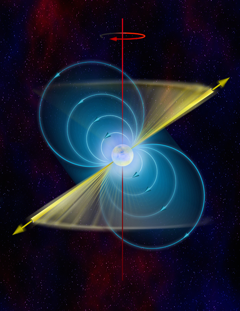So you need some introductory material on pulsars — maybe because you're going to work on a NANOGrav project, or a pulsar search program like PALFA. Here's a reading list to get you started, and a link to the Summer Student Start-up Sheet (updated Summer 2019).
Contents
History:
- Hewish, Bell, et al. (1968), Observation of a Rapidly
Pulsating Radio Source, Nature, 217, 709.
(ADS
| Direct PDF link)
The discovery of pulsars - purely historical interest.
Also: Nobel prize lecture by Hewish. - Hulse & Taylor (1975), Discovery of a Pulsar in a
Binary System, ApJ, 195, L51.
(ADS
| Direct PDF link)
The first binary pulsar.
Also: Nobel prize lecture by Hulse and lecture by Taylor. Don't miss these! - Backer, Kulkarni, et al. (1982), A Millisecond Pulsar,
Nature, 300, 615.
(ADS
| Direct PDF link)
The first millisecond pulsar.
Introductory Reviews:
- Lorimer (2008), Binary and Millisecond Pulsars,
Living Reviews in Relativity, lrr-2008-8.
(Web
| PDF)
A comprehensive observational review. Online version has embedded animations. - Condon & Ransom (2016), Essential Radio Astronomy. (Hardcover
| Online version)
Specifically work through Chapter 6: Pulsars.
Pulsar Timing:
- Cordes (2002), Pulsar Observations I. — Propagation Effects,
Searching Distance Estimates, Scintillations and VLBI,
in Single-Dish Radio Astronomy: Techniques and Applications. (ADS | Direct PDF link)
Advanced technical introduction to observational techniques. - Stairs (2002), Pulsar Observations II. — Coherent Dedispersion
Polarimetry, and Timing,
in Single-Dish Radio Astronomy: Techniques and Applications. (ADS | Direct PDF link)
Advanced technical introduction, part 2. - A beginner-friendly introduction and technical guide by Emilie Parent,
Pulsar timing: from raw data to phase-connected timing solution. (Direct PDF link)
Beyond this material, books like The Handbook of Pulsar Astronomy are useful resources, and the entire literature awaits...
Searching for Pulsars:
- A very basic introduction to pulsar searching, courtesy of the Pulsar Search Collaboratory and Ryan Lynch:
• From the telescope to search output. (PDF)
• Understanding PRESTO search output. (PDF)
Also see the PSC Frequently Asked Questions for help with concepts, and look at the other useful links like the Rogues Gallery.
Also for reference: Scott Ransom's PRESTO tutorial (PDF). - Cordes et al. (2006), Arecibo Pulsar Survey Using ALFA. I. Survey Strategy and First Discoveries, ApJ, 637, 446.
(ADS
| Direct PDF link)
A description of the Pulsar ALFA survey and the first discoveries.
Searching for Single Pulses and Bursts:
- Cordes and McLaughlin (2003), Searches for Fast Radio Transients, ApJ, 596, 1142.
(ADS
| Direct PDF link)
Single pulse search techniques. - Spitler et al. (2014), Fast Radio Burst Discovered in the Arecibo Pulsar ALFA Survey, ApJ, 790, 101.
(ADS
| Direct PDF link)
The first detection of an FRB at Arecibo. (And it turned out to be very special!) - More on FRB 121102:
Spitler et al. (2016), A Repeating Fast Radio Burst, Nature, 531, 202. (ADS)
Chatterjee et al. (2017), A Direct Localization of a Fast Radio Burst and its Host, Nature, 541, 58. (ADS)
Michilli et al. (2018), An Extreme Magneto-Ionic Environment associated with the Fast Radio Burst Source FRB 121102, Nature, 553, 182. (ADS) - A comprehensive introductory review:
Cordes and Chatterjee (2019), Fast Radio Bursts: An Extragalactic Enigma, Annual Review of Astronomy and Astrophysics, 57, 417. (ADS | Direct PDF link ) - Detection algorithms for Transients:
- Generalized Event Finding, a draft by Josh Burt.
See also: Source Finding Algorithms for Fast Transients, and Transient Detection Pipeline, both by Josh Burt. - A description of Friends of Friends, plain text, Jim Cordes
- Generalized Event Finding, a draft by Josh Burt.
Pulsar Timing Arrays and Gravitational Waves:
- Hellings & Downs (1983), Upper limits on the isotropic gravitational radiation background from pulsar timing analysis, ApJ, 265, 39. (ADS)
- Jaffe & Backer (2003), Gravitational Waves Probe the Coalescence Rate of Massive Black Hole Binaries, ApJ, 583, 616. (ADS)
- Classical and Quantum Gravity, Focus issue: Pulsar timing arrays
(2013, Volume 30,
Number 22).
A collection of articles that summarize the 2013 state-of-the-art in detecting gravitational waves with pulsar timing arrays.

